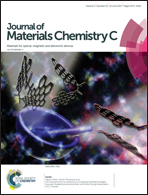UV-curable hybrid organic–inorganic composite inks with a high refractive index for printing interference images and holograms
Abstract
Herein we report a new, facile and inexpensive methodology for obtaining highly refractive polymers suitable for inkjet printing using hexacoordinated titanium complexes (THC) and a UV-curable lacquer based on triethylene glycol dimethacrylate (TGD) that is a cheap and non-toxic monomer that can be rapidly polymerized under UV irradiation under ambient conditions. The resulting polymeric materials are characterized by a refractive index (RI) of about 1.85 in the solid state and have rheological properties suitable for inkjet printing applications. The polymeric materials can be printed onto solid supports resulting in surface structures giving rise to interference images and masking of rainbow holograms illustrating thus the prospective practical applications of the described approach.



 Please wait while we load your content...
Please wait while we load your content...